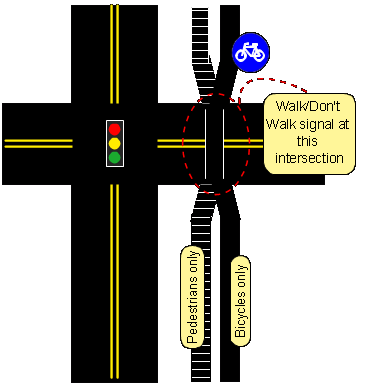My commute takes me on a bike path that runs parallel to a road (with a sidewalk in between). When crossing other roads, the sidewalk and bike path merge, and there is one curb-cut and cross walk with a pedestrian signal. Unless you actually press the button to cross, there will be a green light on the parallel road but a "don't walk" signal for the crosswalk. Should I go anyhow? Should I come to a full stop before doing so, or simply slow down to pedestrian speed and check carefully for turning cars before doing so? Or should I press the button and wait for the pedestrian light?
I'm trying to figure out how "same road, same rules" actually works in practice; the problem is, there are no specific rules for bicycles on bike paths which share crossings with pedestrian crossings, and of course you can't apply the same rules as for cars since cars can't use bike paths.
To clarify, since there seems to be some confusion about the setup of the intersection, there will sometimes be a green light on the road parallel to the bike path, with a "Don't Walk" sign for the crosswalk, and there will sometimes be a green light on the road parallel to the bike path, with a "Walk" sign for the crosswalk (possibly based on whether someone has pushed the button, or possibly based on the timing, I'm not sure). That is, there are times when there's a green light on the parallel road, and cars may turn, but pedestrians (and presumably bikes) are encouraged to cross, and some times when there is a green light on the parallel road, cars may turn, but pedestrians are encouraged not to cross.



